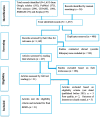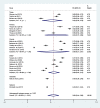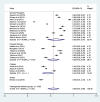Under utilization of long-lasting insecticidal nets (LLINs) is challenging malaria elimination program in Ethiopia: a systematic review and meta-analysis
- PMID: 38491483
- PMCID: PMC10941431
- DOI: 10.1186/s12889-024-18344-w
Under utilization of long-lasting insecticidal nets (LLINs) is challenging malaria elimination program in Ethiopia: a systematic review and meta-analysis
Abstract
Background: Malaria is one of the most common causes of morbidity and mortality in developing countries including Ethiopia. Mass distribution of insecticide-treated nets and indoor residual spray for high malaria risk groups are the major prevention measures in different countries. Achievement of the malaria elimination plan is highly determined by the level of effective utilization of intervention measures. However, there is scarce information showing the national level of insecticide-treated nets utilization.
Objective: To estimate the pooled prevalence of insecticide-treated nets utilization in Ethiopia, 2023.
Method: A Systematic Review and Meta-analysis employed to assess the utilization of long-lasting insecticidal nets in Ethiopia. Published articles were searched from Google Scholar, PubMed, Web Sciences, CINAHIL, EMBASE, and Scopus. The collected articles were screened for data extraction and further analysis using preferred reporting items for systematic review and meta-analysis (PRISMA) flow chart. The quality of each study was assessed using the Jonna Briggs Institute (JBI) checklist. The data were extracted using Microsoft Excel and exported to STATA version 17.0 for analysis. The overall pooled prevalence of long-lasting insecticidal nets utilization was determined using a random effects model.
Result: Out of 1657 articles reviewed, only 21 of them were eligible for final analysis. All of the included studies were used to estimate the pooled prevalence of long-lasting insecticidal net utilization. The point prevalence of LLIN utilization ranged from 14.23 to 91.9%. The Meta-analysis estimated that the overall pooled prevalence of insecticidal nets utilization among all study participants in Ethiopia was 56.26% (95%CI: 44.04-68.48%). Subgroup analysis revealed that insecticidal nets utilization was relatively highest in the Amhara region [63.0, 95%CI (37.0-89.0%)] and during 2020-2023 [61, 95% CI (53.0-69.0%)].
Conclusion: Long-lasting insecticidal nets utilization in Ethiopia is lower than the national target plan. Hence, it needs extra follow-up and intervention to enhance its utilization.
Keywords: Ethiopia; LLIN; Meta-analysis; Systematic review; Utilization.
© 2024. The Author(s).
Conflict of interest statement
The authors declare no competing interests.
Figures






Similar articles
-
Barriers of persistent long-lasting insecticidal nets utilization in Northwest Ethiopia: a qualitative study.BMC Public Health. 2024 Oct 15;24(1):2828. doi: 10.1186/s12889-024-20319-w. BMC Public Health. 2024. PMID: 39407213 Free PMC article.
-
Low long-lasting insecticidal net use in malaria elimination areas in Southern Ethiopia: results from community based cross-sectional study.Malar J. 2024 Apr 4;23(1):94. doi: 10.1186/s12936-024-04909-y. Malar J. 2024. PMID: 38575937 Free PMC article.
-
Assessment of long-lasting insecticide nets coverage, utilization, and associated factors among households in malaria elimination districts of Arsi Zone, Oromia Region, Ethiopia: A cross-sectional study.PLoS One. 2023 Nov 2;18(11):e0293728. doi: 10.1371/journal.pone.0293728. eCollection 2023. PLoS One. 2023. PMID: 37917649 Free PMC article.
-
Piperonyl butoxide (PBO) combined with pyrethroids in insecticide-treated nets to prevent malaria in Africa.Cochrane Database Syst Rev. 2018 Nov 29;11(11):CD012776. doi: 10.1002/14651858.CD012776.pub2. Cochrane Database Syst Rev. 2018. Update in: Cochrane Database Syst Rev. 2021 May 24;5:CD012776. doi: 10.1002/14651858.CD012776.pub3. PMID: 30488945 Free PMC article. Updated.
-
Piperonyl butoxide (PBO) combined with pyrethroids in insecticide-treated nets to prevent malaria in Africa.Cochrane Database Syst Rev. 2021 May 24;5(5):CD012776. doi: 10.1002/14651858.CD012776.pub3. Cochrane Database Syst Rev. 2021. PMID: 34027998 Free PMC article.
Cited by
-
A decline in the coverage and utilization of long-lasting insecticidal nets in Southern Ethiopia: A repeated cross-sectional study.PLoS One. 2025 Apr 24;20(4):e0322342. doi: 10.1371/journal.pone.0322342. eCollection 2025. PLoS One. 2025. PMID: 40273149 Free PMC article.
-
Determinants of Long-Lasting Insecticide-Treated Bed Net Utilization Among Pregnant Women in Gechi District, Buno Bedele Zone South West Ethiopia: A Community-Based Cross-Sectional Study.Environ Health Insights. 2025 May 11;19:11786302251335135. doi: 10.1177/11786302251335135. eCollection 2025. Environ Health Insights. 2025. PMID: 40356943 Free PMC article.
-
Low ITN utilization among households in SWEPR Ethiopia: challenge for malaria elimination, a mixed design approach.BMC Public Health. 2025 Feb 5;25(1):472. doi: 10.1186/s12889-025-21547-4. BMC Public Health. 2025. PMID: 39910469 Free PMC article.
References
-
- CDC. Centers for Disease Control and Prevention. Available from https://www.cdc.gov/malaria/malaria_worldwide/impact.html (accessed on April 2 2023).
-
- WHO. Malaria Key Facts. [online]. available from:https://www.who.int/news-room/fact-sheets/detail/malaria (accessed on April 2 2023).
-
- WHO. World Health Organization. The Global Health Observatory. Available from https://www.who.int/data/gho/data/themes/malaria accessed on April 2 2023.
-
- WHO. World Malaria Report 2022. Available from https://www.who.int/publications/i/item/9789240064898 (accessed on April 2 2023).
Publication types
MeSH terms
LinkOut - more resources
Full Text Sources
Medical

